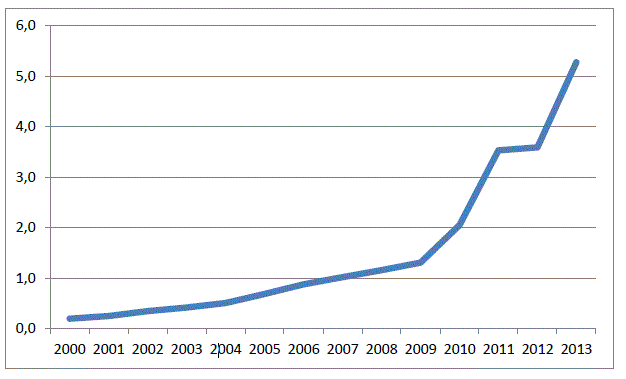A new, damning study published by the Cologne Institute For German Economics confirms what critics of renewable energy feed-in acts have been saying, and quite loudly, all along for years: The poor are getting screwed and the rich are benefiting. Redistribution from bottom to top.
The cost in euro-cents per kw-hr that renewable electricity in Germany has added to the price of electricity. Source: BDEW, 2012
That’s why we at NTZ decided to install solar panels on our home. We prefer being on top, and not always the ones getting screwed. My decision had nothing to do with “rescuing the climate”.
Here are some excerpts of the press release by the Cologne Institute:
Poor households are especially burdened
The redistribution effect of the Renewable Energy Act (EEG) is producing a socially precarious situation, a study by the Cologne Institute For German Economics (IW) has determined. Low income earners are burdened by the extra costs stemming from green electricity just as much as rich households.
This is mainly due to the fact that energy consumption changes very little as income rises. That means the financially strained households are significantly more burdened. The planned power price increases will exacerbate this effect even more: The poorest 10% by income have to pay about 1.3% of their income in order to finance the feed-in of renewable energy. With the top 10% by income, they only need to pay 0.2%.
The redistribution effect is further enhanced by the installation of private photovoltaic systems. There are very few solar households among low-wage earners. Among the rich, however, 20% of the households operate a solar power system. In total the approximately 1 million solar households (about 2.5 percent of the more than 40.4 million private households in Germany) received in 2011 a surplus of about 1 billion euros. More than half of this amount flowed to the top three income deciles.”
Summary: When it comes to generating electricity with wind, solar and biogas, it’s the rich, high-income property owners who benefit. The people who end up picking up the tab are the very poor.
It’s no wonder 600,000 households had their power shut off last year because they were unable to pay their electric bills. Welcome to Europe’s compassionate green socialism.






It is nice to see the real numbers. The concept is understood by everyone except the politicians that pass the subsidy laws. For example, back in 2009, a rich person could by an all electric Tesla Roadster in the State of Colorado for $109,900 and get a total tax credit of $42,083. Not even the middle income folks think a >100K car is for them even with that big discount. This made the news because it was so large and direct, unlike the redistribution via the indirect and hidden flow of which you wisely partake.
Have you read about Jay Leno’s Green Garage:
http://www.jaylenosgarage.com/extras/articles/solar-power-jays-green-garage/index.shtml
The EEG is not the only problem. There’s also the 120% tax on fuel, the 300% tax on cigarettes and climbing real estate prices due to building insulation costs
It’s the same here in the Philippines. We have a Renewable Energy (RE) law of 2008 that also has provisions on feed in tariff (FIT) and renewable portfolio standards (RPS) that ensures the RE companies of mandatory markets and consumers. Enforcement of FIT though was delayed for about 2 years because of some public opposition, but the RE companies lobbied hard so it was implemented later this year. Same transfer of money, from ordinary energy consumers to the rich and super rich, http://funwithgovernment.blogspot.com/2012/07/energy-econ-2-renewable-energy-and-high.html
It looks to me like they only talk about the FIT cross subsidy (EEG-Umlage) that households have to pay. And their conclusions about that are correct.
But it is only part of the redistribution. All FIT payments in 2012 summed up to 20 bn EUR. Only a third of electricity is consumed by households, so they pay about 7 bn EUR of the 20.
The rest is payed by companies (the ones who have not gotten themselves an excemption that is) and by the public sector, about another 7 bn EUR each.
So, only about a third is directly paid by the electricity ratepayer. The 2nd third is paid through taxes (that’s how the public sector recuperates its costs); the 3rd is paid through increased prices (recuperation of cost by business).
Of course this paints a more nuanced picture as the richer households pay more taxes. But I just wanted to point out that the people who made the study forget about two thirds of the total costs and so vastly underestimate the economic consequences of the subsidation.
[…] https://notrickszone.com/2012/12/17/damning-german-study-confirms-renewable-energy-feed-in-act-redist… […]